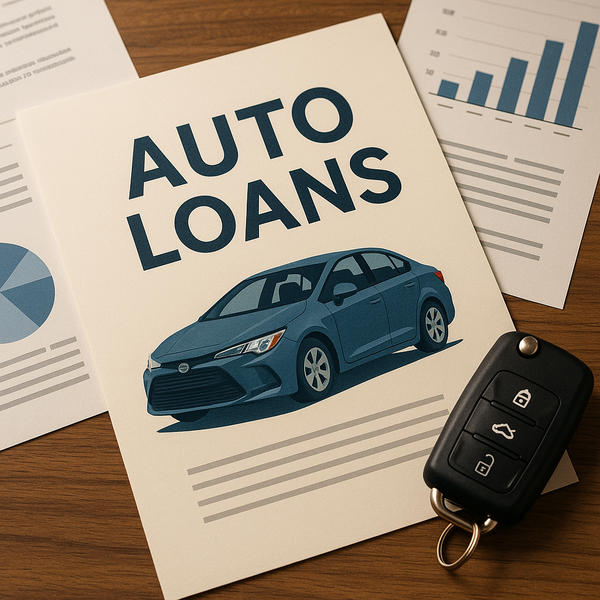
Understanding auto loans is a critical step before buying a car. It involves navigating complex terms, interest rates, and application processes that can significantly impact your financial future and the total cost of your vehicle. This guide aims to demystify auto financing, helping you make informed decisions whether you're buying new or used, from a dealership or a private seller.
What is an Auto Loan?
An auto loan is a secured loan specifically used to purchase a vehicle. The vehicle itself serves as collateral, meaning if you fail to repay the loan, the lender can repossess the car. Auto loans are typically paid back over a set period, known as the loan term, through regular monthly payments that include both principal (the amount borrowed) and interest (the cost of borrowing).
Key Components of an Auto Loan
Several factors determine the total cost and manageability of your auto loan:
Principal Amount
This is the initial amount borrowed to purchase the vehicle. It's usually the purchase price minus any down payment and trade-in value.
Interest Rate (APR)
The interest rate is the percentage charged by the lender for borrowing the principal. The Annual Percentage Rate (APR) includes the interest rate plus any fees, providing a more accurate picture of the total cost of borrowing over the loan term. A lower APR means lower monthly payments and less interest paid over time.
Loan Term
The loan term is the duration over which you agree to repay the loan, typically expressed in months (e.g., 36, 48, 60, 72 months). Longer loan terms mean lower monthly payments but result in paying more interest over the life of the loan and potentially owing more than the car is worth (being underwater on the loan) as it depreciates.
Down Payment
A down payment is an upfront cash payment towards the vehicle's purchase price. Making a larger down payment reduces the principal amount borrowed, which lowers your monthly payments and the total interest paid. It also helps avoid being underwater on the loan.
Fees
Auto loans can come with various fees, such as origination fees, documentation fees, late payment fees, and prepayment penalties. It's important to understand all potential fees before signing the loan agreement.
Types of Auto Loans
Auto loans can originate from different sources:
Dealership Financing
Many car dealerships offer financing options, often through relationships with various banks and financial institutions. This can be convenient, as you can arrange financing and purchase the car in one place. However, dealership financing might not always offer the best interest rates, as the dealer may add their own markup.
Bank and Credit Union Loans
Banks and credit unions are traditional sources for auto loans. Credit unions, in particular, often offer competitive interest rates to their members. Getting pre-approved by a bank or credit union before visiting a dealership gives you leverage during price negotiations and a clear understanding of the interest rate you qualify for.
Online Lenders
Numerous online lenders specialize in auto financing, often offering quick application processes and competitive rates. Comparing offers from multiple online lenders can be a good way to find favorable terms.
The Auto Loan Application Process
Applying for an auto loan typically involves submitting a formal application, which requires personal information, employment details, and financial history. The lender will then review your creditworthiness by checking your credit report and score.
Credit Score Impact
Your credit score is a significant factor in determining your eligibility for an auto loan and the interest rate you'll be offered. A higher credit score indicates a lower risk to lenders, typically resulting in lower interest rates and better terms. It's wise to check your credit score before applying and take steps to improve it if necessary.
Getting Pre-Approved
Getting pre-approved for an auto loan before you start car shopping is highly recommended. Pre-approval involves a lender reviewing your credit and income to determine how much you can borrow and at what interest rate. This process provides you with a budget, simplifies negotiations at the dealership, and allows you to focus on finding the right car, knowing your financing is secured.
Calculating Your Monthly Payment
Several online calculators can help you estimate your monthly auto loan payment based on the principal amount, interest rate, and loan term. Understanding how these factors interact allows you to budget effectively and determine what kind of car and loan term are affordable for you.
Refinancing an Auto Loan
If you've already secured an auto loan but your credit score has improved, interest rates have dropped, or you want to change your loan term, you may be able to refinance. Refinancing involves taking out a new loan to pay off your existing one, potentially resulting in a lower interest rate or different monthly payment.
Understanding the Loan Agreement
Before signing any loan documents, carefully read and understand all the terms and conditions. Pay close attention to the APR, loan term, total amount financed, total interest paid, and any fees or penalties. Don't hesitate to ask the lender questions about anything you don't understand.
Conclusion
Navigating the world of auto loans doesn't have to be overwhelming. By understanding the key components like interest rates, loan terms, and the impact of your credit score, and by exploring different financing options, you can secure a loan that fits your budget and helps you drive away in your desired vehicle without financial strain. Always compare offers and read the fine print before committing.

